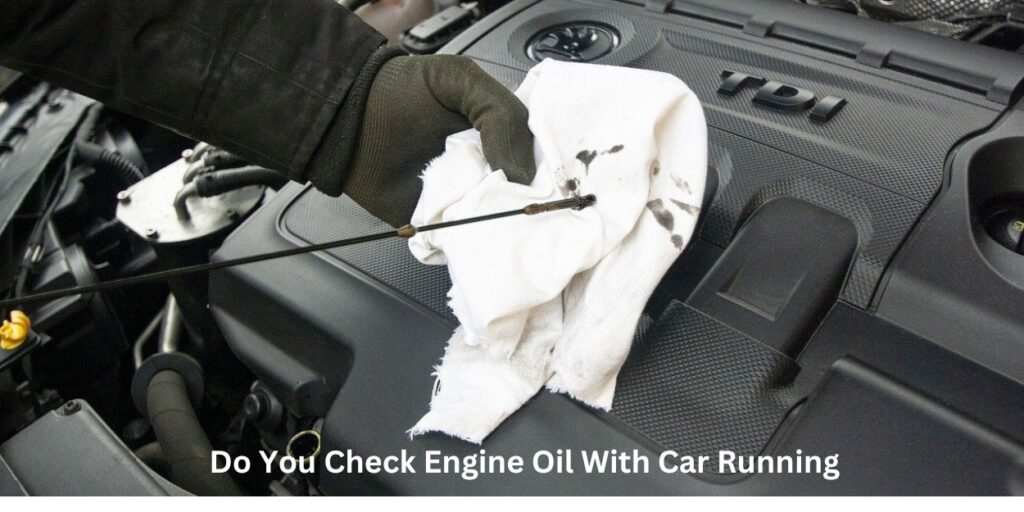Do You Check The Oil With The Car Running

The humble dipstick. Arguably one of the most important tools for engine health, yet also a source of much confusion. Today, we're diving deep into a question that's sparked countless garage arguments and forum flame wars: Do you check your oil with the engine running? The short answer? It depends. But like a poorly tuned carburetor, the details are where things get interesting.
The Traditional (And Generally Safer) Method: Engine Off
For the vast majority of cars on the road, the *correct* procedure is to check the oil with the engine off. This allows the oil to drain back into the pan, providing a more accurate reading. Here's a general guide:
- Park your car on a level surface.
- Let the engine cool down for at least 5-10 minutes (longer is better, especially after a spirited drive).
- Locate the dipstick (usually brightly colored and easy to spot).
- Pull the dipstick out and wipe it clean with a lint-free rag.
- Reinsert the dipstick fully.
- Pull the dipstick out again and check the oil level. It should be between the "MIN" and "MAX" marks.
- Add oil as needed, using the correct viscosity and type for your engine.
Why this method? Simple. Safety. Checking the oil with the engine off eliminates the risk of injury from moving parts or hot engine components. It also allows gravity to do its work, ensuring a more representative oil level reading.
The Exception to the Rule: Certain Rotary Engines (and a few Others)
Now, here's where things get spicy. Some rotary engines, most notably those found in the Mazda RX-7 and RX-8, *require* a running engine for an accurate oil level check. Why? The design of these engines, with their rotating housings and eccentric shafts, means that oil distribution is significantly different when running compared to when stationary.
How to do it (Rotary Engine Style):
- Start the engine and let it idle for a few minutes to reach operating temperature.
- With the engine still running, park on a level surface.
- Carefully remove the dipstick, wiping it clean as usual.
- Reinsert the dipstick fully.
- Remove the dipstick again and check the oil level.
Important Considerations for Rotary Engines:
- Be *extremely* careful to avoid touching any moving parts or hot components.
- Refer to your owner's manual for specific instructions. This is crucial!
- Don't overfill! Overfilling a rotary engine is significantly worse than being slightly low.
But rotary engines aren't the only exception, though they are the most prominent. Some very old engines with unique oiling systems may also require a running oil check. Always consult your owner's manual.
Modern Tech and the Vanishing Dipstick
The rise of electronic oil level sensors is making the dipstick a relic of the past in some modern vehicles. These systems provide a digital reading on the dashboard, eliminating the need to physically check the oil. While convenient, these systems aren't foolproof and relying solely on them can sometimes lead to missed problems. Always consult your owner's manual to understand how the sensor functions and when/how to check for potential issues. A quick visual inspection under the car for leaks is also a good practice, even with electronic sensors.
Pros and Cons: Engine On vs. Engine Off
| Method | Pros | Cons | Applicable Engines |
|---|---|---|---|
| Engine Off | Safer, more accurate for most engines, allows oil to drain back into the pan. | Requires waiting for the engine to cool down. | Most gasoline and diesel engines. |
| Engine On | More accurate for certain rotary engines, reflects real-time oil distribution. | Significantly higher risk of injury, requires careful execution, not applicable to most engines. | Specific rotary engines (e.g., Mazda RX-7, RX-8), some very old engines. |
| Electronic Sensor | Convenient, provides real-time oil level information (potentially). | Can be unreliable, may not detect subtle leaks, requires trusting the electronics. | Many modern vehicles. |
Real-World Driving Impressions: The Importance of Regular Checks
Whether you're checking with the engine on or off, the *most* important thing is to check your oil *regularly*. A low oil level can lead to catastrophic engine damage, especially under demanding driving conditions. I remember a track day where a friend's engine seized up after ignoring a slowly developing oil leak. A simple dipstick check could have saved him thousands of dollars! Another driver I know had similar issues with an older BMW with a slow head gasket leak, early detection and regular top-ups prevented lasting damage.
For those with rotary engines: the engine on check is not just recommended, it's essential. Don't skip it! And for everyone else, stick to the engine-off method for safety and accuracy.
The Final Word (and a Little Controversy)
Ultimately, the question of whether to check your oil with the engine running boils down to this: read your owner's manual! It's the definitive guide for your specific vehicle. However, even with all the advancements in automotive technology, the dipstick remains a vital tool for maintaining engine health.
Now, here's the fun part: I've heard stories of some old-school mechanics swearing by *slightly* tilting the car to get an even more accurate reading. Myth or method? Let the debate begin!
